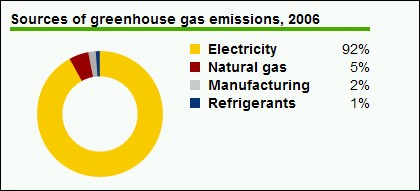HP: Climate
From Lauraibm
Contents |
MI Summary
Text of Article
Governments, businesses and individuals must all play a role in reducing greenhouse gas (GHG) emissions that cause climate change. Increasingly, our customers and shareholders expect us to decrease our climate impact. Against a background of rising global energy prices, there is a strong business case for investing in energy efficient technology. HP continues to lead the IT industry in reducing the energy used by our operations and products.
Greenhouse gas emissions
HP's most significant source of greenhouse gas (GHG) emissions from operations is energy consumption, primarily electricity. Energy use accounts for 97% of our GHG emissions. Our environmental operations strategy focuses on consolidating our operations into core sites, with our HP Workplace Transformation initiative enabling us to improve space utilization and install more energy efficient equipment, in a phased approach over time. Our goal is to reduce energy consumption and the resulting carbon dioxide emissions from HP owned and HP leased facilities worldwide to 15% below 2006 levels, by 2010.
We are expanding our use of renewable energy, by purchasing green electricity and installing onsite generation at selected locations.
Performance
Although our total energy use in operations decreased by 1% from 2005 to 2006, our 2006 emissions of greenhouse gases increased 3% or by 47,200 tonnes of CO2 equivalent. This is due to changes in the global energy mix for electricity generation. In April 2006, the World Business Council for Sustainable Development (WBCSD) and the World Resources Institute (WRI) updated its GHG Protocol emission factors for electricity generation, to reflect these changes. Using the old factors, HP's GHG emissions would have decreased 5%.
Emissions per unit of floor space increased 5% due to the changes in electricity conversion factors and a 2% reduction in floor space. Emissions per unit revenue, a measure of overall efficiency, decreased by 3%.
Perfluorocarbons
Perfluorocarbons (PFCs) are gases used widely in the semiconductor industry for cleaning and etching processes. The global warming potential of PFCs ranges from 6,500 to 23,900 times greater than CO2.
In the United States, HP participates in the PFC Reduction Climate Partnership, a voluntary initiative with the U.S. Environmental Protection Agency (EPA) to reduce specified PFC emissions by 10% from 1995 levels by the end of 2010. In 2006, HP decreased its PFC emissions by 59% from 2005, to 34% below the 1995 level. Installing additional abatement technology at our manufacturing plants enabled us to meet the 2010 EPA goal in 20061.
(2)
Source
- 2. Climate



